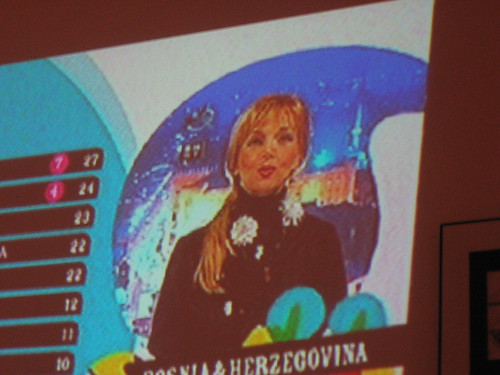My next session I get to be a slightly more passive person again. This one is on "Visual Interactivity" and is being given by Jeff Ballinger who works for a company called Mobileacuity and he says we should throw things at him if he gets too salesy...
Visual interactivity is the topic up for discussion.
Background:
- Most people have phones they use for voice calls
- Most people send text messages
- Many have cameras on their phone. In a more regular group of punters there are a few less than in this room
- About 5% (if that) have visited a web site on their phone (in our room about 60%)
- Very very few folk have downloaded apps or games (we're much higher than average)
What are the implications for folk on the street. Cameras are used widely. More sophisticated things like browsers etc. are not used very much.
Jeff's company works in brand marketing spaces. They want to use mobile with other mediums. They really want wide usage for it to be useful. It must be inclusive and it cannot put people off (real danger in brand marketing). But perhaps these issues raise the difference between good and bad mobile content.
We're seeing a graph. Most now have camera phones.
Showing 3D barcode: has to be printed on original media. Nice to redirect what it points to. The reason most QR type codes are fairly static. This is to do IPR. NeoMedia Technologies have a patent for any redirection via an image. They did this in about 1995 so did originate in this stuff but it makes it hard to get into it now. There is a real usability barrier here as well. How can you tell that
In 2008, 166.6m handsets in Western Europe are registered for MMS usage - 95% of phones. And ages 16-34 generally know how to send MMS.
Recognition
Very simple form of interactivity. Take picture, recognize and then send back content. Q, basic. You take a picture and get sent back data. It's handy but it's really not that useful or exciting. Only great if loads of media are involved. The number for this sort of interactivity has to be communicated to users somehow. Questions raised about trust issues. Any call to action tends to be situational. Mobileacuity tend not to put out a number for responses to help for that.
Image Zoning
A bit more sophisticated. You take a picture with the centre focused on an action point (e.g. Vodafone guess the goal scoring point interaction). Offers better and wider possibilities. another example done by agency AKQA for Nike PhotoiD. A way to customize shoes by taking pictures of the colours you like, you get sent back a mocked up shoe in that colour (from set palate) and a link to buy. Colour analysis being used as input for mobile shopping.
Blue Screening
As in the movies (or in the beach of old!) you can star in an image. You could take pictures of yourself pocking head through a sign and then the service can return content (e.g. a music video) using this. Limited by physical location of boards etc.
Facefinder
Is latest idea on this. It just uses a regular image so can be used better for social apps. Now getting a demo from some friendly faces in the front row! ;) A picture is taken and sent off to the company servers. And a video gets sent back. Really quite fun. Cost of download of video depends on package. 500k is about the video size. Contracts vary. Vodafone do inclusive data. T-Mobile and 3 have add ons but inexpensive and good take up. Other operators not such easy models yet. You can do viral things to build on that content. Could use GPS into apps on some phones but phone dependent. Mobileacuity is focusing on visual end, apps specialists build the apps.
It's very easy to find face like features in an image. There is some false positive confusion here. Can be tricky to separate real from unreal faces. Finding the edge of a face without a fixed template is also tricky.
Now watching demo video from MobileExpo this year. This prompts a question about serious uses other than teenage silliness. There is a project that Jeff is working on that is a public information service (but he can't tell us about it) but there are also ways of getting data on products and services. Snaptel in the US (in Snaptel Explorer) lets you take a picture of DVD, product etc. and then link to tons of data - real time data when making purchasing decisions.
One useful implication could be to tag a face and then search based on it in image searching tools (some common ground here with iPhoto face recognition).
Visual search over text search has an advantage in terms of specificity. e.g. search for Paris and you get the city, you get Paris Hilton etc. If you take a picture of the Eiffel Tower you'll only get info on the Eiffel Tower. Talk here that a theatre listings could be returned from a picture of that theatre.
More demos are being handed out. I am pausing over them as my data package is not that great.
Discussion: there are manual cut out options and web based ideas. Mobileacuity are in discussion with various agencies about options. Someone asked about Facebook - send from phone and return to Facebook or similar.
There are several competitors. All but one uses a licensed software option that limits options. Mobileacuity uses something different and is leading in UK (and only in UK it seems) with clients including Ogilvy, Joule, Nokia, Pepsi, Vodafone, BBC, etc. Mobileacuity is looking at a web service API in a few months. Once it's finished it will be rolled out more widely.
Eurovision_Nicola's Twitterrings...
Saturday, 14 March 2009
Subscribe to:
Post Comments (Atom)




No comments:
Post a Comment